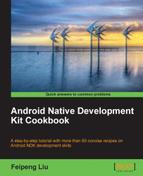You may often need to use a library in multiple projects.
You can put the library in each of the project's jni folders and build them separately. However, it is troublesome to maintain multiple copies of the same library. For example, when there is a new release of the library and you want to update the library, you will have to update each copy of the library.
Fortunately, Android NDK provides a feature to allow us maintain a library module outside a NDK project's main source tree and import the module with simple commands in the Android.mk file. Let's discuss how to import a module in this recipe.
The following steps describe how to declare and import a module outside of a project's jni folder:
- Create an Android application named
ImportModulewith native support. Set the package name ascookbook.chapter8.importmodule. Please refer to the Loading native libraries and registering native methods recipe of Chapter 2, Java Native Interface for more detailed instructions. - Add a Java file
MainActivity.javaunder thecookbook.chapter8.importmodulepackage. This Java file simply loads the shared libraryImportModule, and calls the native methodnaCreateABmp. - Download the
libbmplibrary from http://code.google.com/p/libbmp/downloads/list and extract the archive file. Create a folder namedmodulesunder the project and a folderlibbmp-0.1.3under themodulesfolder. Copy thesrc/bmpfile.candsrc/bmpfile.hfiles from the extracted folder to thelibbmp-0.1.3folder. - Follow step 3 of the Porting a library as shared library module with Android NDK build system recipe to update
src/bmpfile.h. - Create an
Android.mkfile under thelibbmp-0.1.3folder to compilelibbmpas a static librarylibbmp.a. The content of thisAndroid.mkfile is as follows:LOCAL_PATH := $(call my-dir) include $(CLEAR_VARS) LOCAL_MODULE := libbmp LOCAL_SRC_FILES := bmpfile.c LOCAL_EXPORT_C_INCLUDES := $(LOCAL_PATH) include $(BUILD_STATIC_LIBRARY)
- Add the
mylog.handImportModule.cfiles to it.ImportModule.cimplements the native methodnaCreateABmp. - Create an
Android.mkfile under thejnifolder to compileImportModule.cas a shared librarylibImportModule.so. The content of thisAndroid.mkfile is as follows:LOCAL_PATH := $(call my-dir) include $(CLEAR_VARS) LOCAL_MODULE := ImportModule LOCAL_SRC_FILES := ImportModule.c LOCAL_LDLIBS := -llog LOCAL_STATIC_LIBRARIES := libbmp include $(BUILD_SHARED_LIBRARY) $(call import-add-path,$(LOCAL_PATH)/../modules) $(call import-module,libbmp-0.1.3)
- Add the
WRITE_EXTERNAL_STORAGEpermission to theAndroidManifest.xmlfile as follows:<uses-permission android:name="android.permission.WRITE_EXTERNAL_STORAGE"/>
- Build and run the Android project. A bitmap file
test_bs_static.bmpshould be created at thesdcardfolder of the Android device. You can use the following command to get the file:$ adb pull /sdcard/test_im.bmp .
The file is the same as
test_static.bmp, as shown in the Porting a library as shared library module with Android NDK build system recipe of this chapter.
In your sample project, you created a module outside the jni folder of the project and then imported the module for building the shared library libImportModule.so. The following steps should be performed when you declare and import a module:
- Declare the import module: There is nothing special in declaring an import module. Since an import module is usually used by multiple NDK projects, it is a good practice to export the header files (with
LOCAL_EXPORT_C_INCLUDES), compiler flags (LOCAL_EXPORT_CFLAGSorLOCAL_EXPORT_CPPFLAGS), and linker flags (LOCAL_EXPORT_LDLIBS) when declaring the import module.In our sample project, you declared an import static library module
libbmp. - Decide the place to put the import module: The Android NDK build system will search the paths defined in
NDK_MODULE_PATHfor the import modules. By default, thesourcesfolder of the Android NDK directory is appended toNDK_MODULE_PATH. Therefore, you can simply place our import module folder under thesourcesfolder and the Android NDK build system will be able to find it.Alternatively, you can place the import module folder anywhere and append the path to
NDK_MODULE_PATH. In our sample project, place the import thelibbmpmodule in themodulesfolder. - Append the import path: This is not needed when placing the import module folder under the
sourcesdirectory of Android NDK. Otherwise, you will need to tell the Android NDK build system where the import modules are, by appending the path toNDK_MODULE_PATH. Theimport-add-pathmacro is provided by NDK to help you to append the path.In your sample project, you appended the
modulesfolder toNDK_MODULE_PATHwith the following line atjni/Android.mk:$(call import-add-path,$(LOCAL_PATH)/../modules)
- Import the module: Android NDK provides a macro
import-moduleto import a module. This macro accepts a relative path to the import module's folder where theAndroid.mkfile of the import module is located. The Android NDK build system will search for all the paths defined atNDK_MODULE_PATHfor the import module.In your sample project, you imported the module with the following line at the
jni/Android.mkfile:$(call import-module,libbmp-0.1.3)
The NDK build system will search for the
libbmp-0.1.3/Android.mkfile at allNDK_MODULE_PATHdirectories for the import modules. - Use the module: Using an import module is just like using any other library module. You will need to link to the library by listing it at
LOCAL_STATIC_LIBRARIESfor the static library import module andLOCAL_SHARED_LIBRARIESfor the shared library import module.
For more information about how to import modules, you can refer to docs/IMPORT-MODULE.html at Android NDK.
